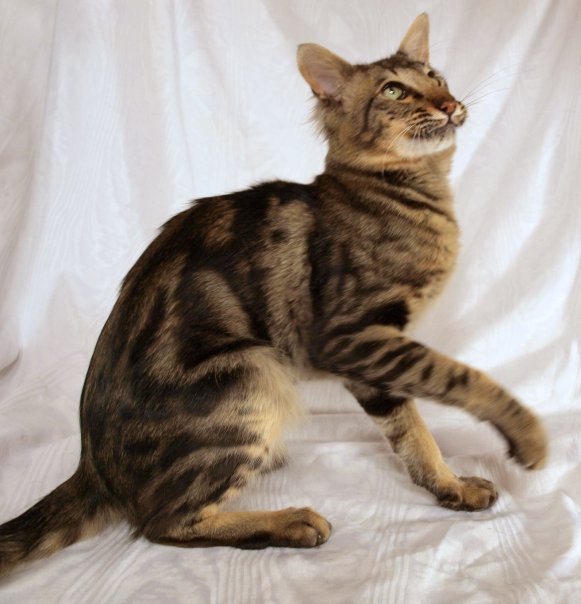
Various terms are used for specific colors, for example, gray is also called blue, orange is also called ginger. Orange becomes cream, black becomes gray, etc. The (B) and (O) genes can be further modified by a recessive dilute gene (dd) which softens the colors. Tortoiseshell and calico cats are labeled X OX o, indicating O gene heterozygy. Typically, the alleles are notated as an uppercase O for orange, or a lowercase o for not-orange. The primary gene for coat color (B), for the colors brown, chocolate, cinnamon, etc., can be masked by the co-dominant gene for the orange color (O), which is on the X chromosome and has two alleles: orange (X O) and not-orange (X o) that produce orange phaeomelanin and black eumelanin pigments, respectively. Tortoiseshell and calico coats result from an interaction between genetic and developmental factors. Chocolate tortoiseshell Asian cat with white spotting on her neck

In the course of his studies he discovered that the rare tortoiseshell male is often sterile. Leonard Doncaster was the first to prove that tortoiseshell is the female heterozygote of orange and black, the corresponding male being orange. ( October 2012) ( Learn how and when to remove this template message) Unsourced material may be challenged and removed. Please help improve this article by adding citations to reliable sources in this section. This section needs additional citations for verification. Tortoiseshell coloring can also be expressed in the point pattern, referred to as a tortie point. Not uncommonly there will be a "split face" pattern with black on one side of the face and orange on the other, with a dividing line running down the bridge of the nose. These patched tabbies are often called a tortie-tabby, a torbie or, with large white areas, a caliby. Occasionally tabby patterns of black and brown (eumelanistic) and red (phaeomelanistic) colors are also seen. Dilution genes may modify the coloring, lightening the fur to a mix of cream and blue, lilac or fawn the markings on tortoiseshell cats are usually asymmetrical. Typically, the more white a cat has, the more solid the patches of color. The size of the patches can vary from a fine speckled pattern to large areas of color. Tortoiseshell cats have particolored coats with patches of various shades of red and black, and sometimes white. Patterns Cat with a blue ("dilute") tortoiseshell coat A tortoiseshell with characteristic "split-face" pattern This pattern is especially preferred in the Japanese Bobtail breed, and exists in the Cornish Rex group. Tortoiseshell markings appear in many different breeds, as well as in non-purebred domestic cats. Ĭats with a tortoiseshell pattern and small blotches of white are sometimes referred to as "tortico", a portmanteau of "tortie" and "calico". Those that are predominantly white with tortoiseshell patches are described as tricolor, tortoiseshell-and-white, or calico (in Canada and the United States). "Tortoiseshell" is typically reserved for multicolored cats with relatively small or no white markings. Tortoiseshell cats with the tabby pattern as one of their colors are sometimes referred to as torbies or torbie cats. The colors are often described as red and black, but the "red" patches can instead be orange, yellow, or cream, and the "black" can instead be chocolate, gray, tabby, or blue. Tortoiseshell cats, or torties, combine two colors other than white, either closely mixed or in larger patches. Male tortoiseshells are rare and are usually sterile.

Like tortoiseshell-and-white or calico cats, tortoiseshell cats are almost exclusively female. Tortoiseshell is a cat coat coloring named for its similarity to tortoiseshell pattern. Two-color coat coloring in cats A short-haired black tortoiseshell cat


 0 kommentar(er)
0 kommentar(er)
